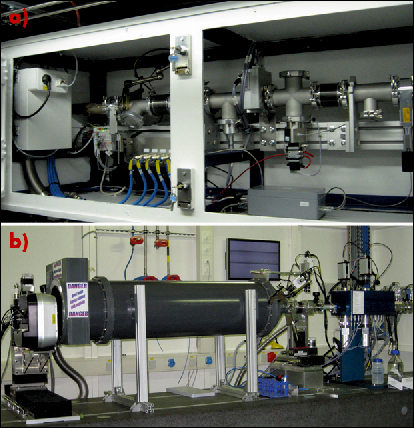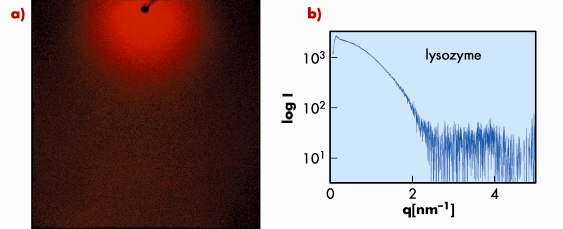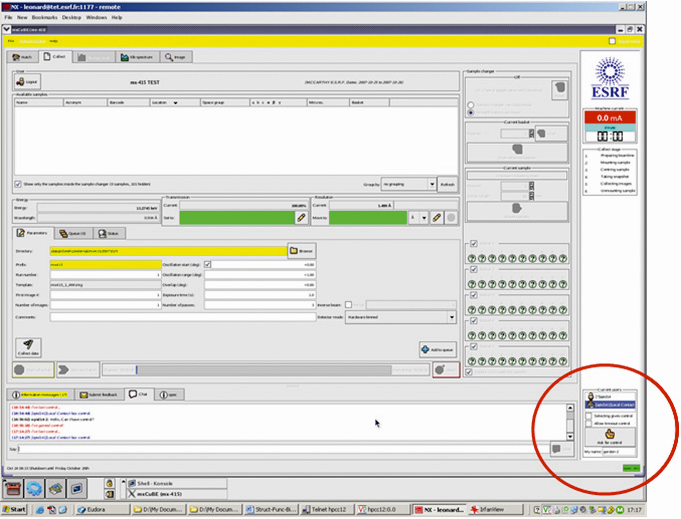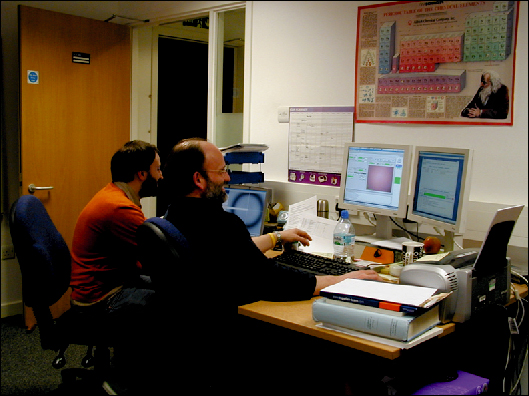- Home
- Users & Science
- Scientific Documentation
- ESRF Highlights
- ESRF Highlights 2008
- Methods and instrumentation
- New technical developments at the ESRF Macromolecular Crystallography Group beamlines
New technical developments at the ESRF Macromolecular Crystallography Group beamlines
ID14-3: A New BioSAXS beamline
In January 2008 work began on the conversion of ID14-3 from a beamline dedicated to single-wavelength macromolecular crystallography experiments to one dedicated to small-angle X-ray scattering from solutions of biological macromolecules (BioSAXS).
The new facility is intended to complement already existing SAXS facilities at the ESRF that are highly oversubscribed for a wide variety of experiments in the fields of biology, chemistry, materials science, etc. With rapidly-growing interest in BioSAXS from the ESRF’s MX User Community, beam-time on the existing resources was set to become even more sought after. Creating a dedicated BioSAXS facility will alleviate the high rate of over-subscription, improve the throughput of such experiments by removing the need for the station to be optimised for every new user group, and result in more beam-time on the ESRF’s existing SAXS end-stations being available for experiments in other fields. An additional benefit of building this new facility at the ESRF is the creation of a collaboration with the already established small-angle neutron scattering (SANS) facility at the ILL. Our intention is to allow users, via a single proposal, to access both facilities for appropriate experiments. This will allow the complementary information provided by neutron scattering (i.e. contrast variation) and X-ray scattering to be obtained in a single visit to the Grenoble site.
The conversion of ID14-3 has been undertaken in stages. The first of these allowed testing of the proposed design and proof-of-principle experiments before the major renovation of the experimental hutch was undertaken. New beam conditioning hardware and redesigned attenuators have been installed upstream of the original ID14-3 focusing optics in order to minimise parasitic scattering. To this end a “mini” hutch (the first of its type at the ESRF) has been built in the ID14 mezzanine (Figure 162) and houses new beam defining slits, the experimental shutter and beam monitoring devices. The experimental hutch has also been refitted and now contains a 4 m long marble table which supports the new experimental equipment. Two pairs of guard slits are mounted prior to the sample exposure unit (quartz capillary tube mounted in vacuum). An evacuated flight tube with variable length (0.5 to 2.5 m) and a fully-motorised beam-stop sits between the sample environment and a (Vantec-2000) 2D gas filled-detector (Figure 162). The commissioning phase of the new BioSAXS facility is now complete and, following positive feedback from a small number of collaborating users during October 2008, the first official experiments took place in November 2008.
 |
|
Fig. 162: a) The ID14-3 “mini” hutch installed under the mezzanine of ID14; b) the newly refurbished ID14-3 BioSAXS experimental hutch. |
The ultimate aim of the conversion of ID14-3 to a dedicated BioSAXS resource is to offer a facility with automatic sample loading/unloading, data collection, processing (conversion of a 2-D image to a normalised 1D X-ray scattering profile, Figure 163) and analysis. This will (rapidly) provide users with standard data concerning the size (radius of gyration, maximum dimension and volume) and molecular weight of samples and allow on-the-fly ab inito shape reconstruction in order to provide feedback enabling data collection strategies to be optimised. Automation of sample loading will be incorporated on the beamline in the coming months using a device being constructed in a collaboration between the EMBL (Grenoble and Hamburg outstations) and the ESRF. Automated data analysis will be implemented following the model of the SAXS facility at X-33, EMBL Hamburg). Future plans extend to allowing remote access to the new facility. This will be based on the system currently in use on the ESRF’s MX end-stations, which is described below.
 |
|
Fig. 163: Lysozyme SAXS data collected at ID14-3: a) 2-dimensional detector image and b) the resulting 1-dimensional X-ray scattering profile. |
Remote access to the ESRF’s MX facilities
Modern Structural Biology calls for short but frequent access to synchrotron radiation based macromolecular crystallography facilities (maximum length of experimental session ~6 shifts). For many of the ESRF’s external users (both academic and industrial) travel to/from Grenoble, as well as being stressful and tiring, often takes up more time than the experiment itself. Remote access to the ESRF’s MX beamlines would mean much less travelling for users. For this, and a number of other reasons, we have developed remote data collection protocols, broadly reflecting the needs of our external users. The modes of remote access currently offered are as follows:
1. Data collection service: Here, instructions concerning the data that users would like to be collected from their samples (‘diffraction plans’) are submitted beforehand via the laboratory information management system (LIMS) ISPyB [1] (http://ispyb.esrf.fr/). ESRF staff then operate the beamlines and take the majority of the decisions concerning data collection. External users can follow progress in real-time using ISPyB and are able to intervene with supplementary instructions should they wish to. This type of remote access is highly labour intensive for in-house staff and so offered only to industrial customers via the well-established MXpress service (see http://www.esrf.fr/Industry).
2. Full remote control: In this mode external users can also avoid travelling to Grenoble by sending samples to the ESRF via a courier company. On the day of the experimental session, the samples are loaded into the robotic sample changers, available on all our MX beamlines, by ESRF staff. The external users connect to the beamline control computer and, after having been given control by the experiment Local Contact, control the beamline from the home laboratory in the same manner as if they were using the beamline locally. ESRF beamline staff remain on call to help in case of problems.
3. ‘Hybrid’ control: In this mode, only a few of the users from an external group travel to the ESRF for a scheduled experimental session. Those remaining in the home laboratory can collect data on the samples that they have contributed to the session via remote control of the beamline. In this mode of remote access, sample changer loading and other ancillary tasks are performed by those users who have travelled to Grenoble.
For the hybrid and full remote control modes, reliable external access to the beamline control computers is essential. For this we use NoMachine/NX software (http://www.nomachine.com). This allows access to an ESRF firewall computer from which remote users can then access and login to the relevant beamline control computer. The MxCuBE Graphical User Interface (GUI) [2] and beamline control applications can then be started. These applications are displayed and manipulated in real-time on the user’s local workstation.
To allow secure remote access to the MX beamlines we developed a master/slave version of MxCuBE (Figure 164). Master instances of the GUI are accessed by beamline staff to set up the beamline and to hand over control to a slave instance of the GUI running from a remote location. The master instance of MxCuBE allows beamline staff to follow the experiment and take back control or intervene when necessary. Slave instances of MxCuBE have a limited scope and in particular, cannot take control from any other instance of the beamline GUI. However, it is possible for slave instances to view all other instances of MxCuBE running on a particular beamline, to transfer control or to communicate with them via a ‘chat’ tab.
 |
|
Fig. 164: A remote instance of the MxCuBE beamline control GUI. The brick allowing transfer of control and an overview of all other mxCuBE instances running at the beamline is circled. |
Following initial tests with the help of groups from the University of York (Figure 165) and the University of Marseilles, hybrid and full remote control access modes were made generally available to external users of the MX beamlines in March 2008. Currently, ~25% of academic and 30% of industrial experimental sessions involve one of these two modes of remote access. We expect these figures to increase rapidly and that remote access will soon become the principal gateway to the ESRF’s MX beamlines for our larger user groups.
 |
|
Fig. 165: J. Turkenburg (right) and S. Hart collecting data on ID14-2 from their office at the University of York. |
Authors
A. Round (a), P. Pernot (b) and G. Leonard (b), on behalf of the ESRF/EMBL Joint Structural Biology Group (JSBG)
(a) EMBL Grenoble Outstation
(b) ESRF
References
[1] A. Beteva, S.M. McSweeney, et al., Acta Cryst. D62, 1162 (2006).
[2] G. Leonard, J. McCarthy, D. Nurizzo, X. Thibault, Synchrotron Radiation News 20, 18 (2007).



